Dharran Calligraphy |
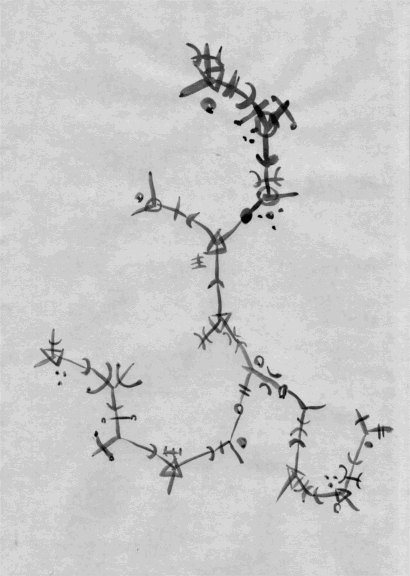 Image from Mikael Johansson |
Booklet on Daharran Grammar
Research group of Linguistic Anatomy | Research group of Exo-morphology Department of Linguistics in cooperation with the Department of Exo-Medicine, Faculty of Exo-Sapient Studies,University of Lek-Jon-Tal: excerpts from the 'Booklet on Daharran GrammarI. Anatomical Notes with Linguistic Relevance
II. Phonetics
III. Introductory notes on Syntax
IV. Paradigms
V. Pronouns
I. Anatomical Notes with Linguistic Relevance
The Daharran communication is mainly based on acoustic signal systems; not too unlike the systems employed by most human/humanoid non-electronic/optical systems known to us as of today. They emit sounds, that may be structured into linguistic systems, and they detect sounds.i. Audii
Most of the Daharran lingual apparatus is posed as various organs on their central breast plate. The inferior side of their bodies is composed by a high number of plates; a feature that still remains as they evolved to include a raised body segment. The Auditory as well as Vocatal apparati are located approximately in the center of the main plate on their raised segment; with vox in the middle and the nine audii in segments of three grouped in an estimation of a circle around it. (See sketch 'Breast Plate')These audii consist of a thin membrane, with an unknown apparatus within to interpret and convey the received sounds. The department has not yet had the opportunity of studying this mechanism in detail, and practically no research on Daharran anatomy is conveyed outside Orwell.
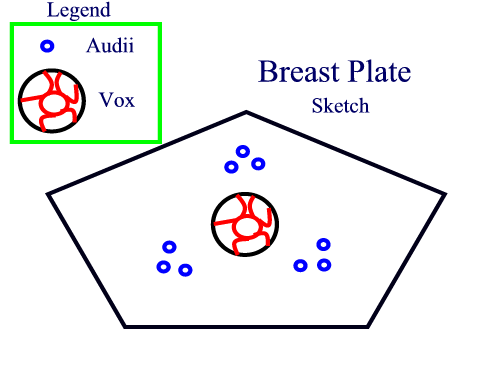 Image from Mikael Johansson |
ii. Vox
Now for something we do know more about. Roughly in the centre of the nine audii lies the vox. It is one of many breathing channels, but unique in some vital ways. Firstly, the vox is the largest by far -- other air-tunnels measure up to approx. 5 cm across, whereas the vox has been observed up to sizes of approx. 20 cm across. Furthermore, it has an organ not too common in air-tunnels elsewhere. The lingua. The lingua is an extremely flexible muscle, fastened in three branches through the walls of the vocal tube. The conical extension of the muscle -- up to some 20 cm long when not actively extended -- is covered with small tubercles or 'prickles', supposedly having some sort of olfactory function. The air ducts that result from the division of the vocal tube by the lingual attachments function as vocal cords. (See Vox Front and Vox Side for sketches of the vox) 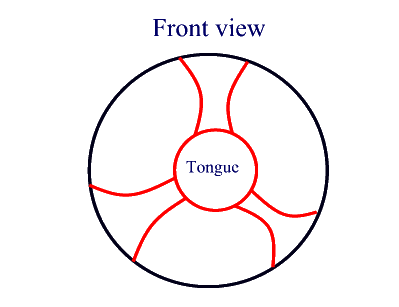 Image from Mikael Johansson |
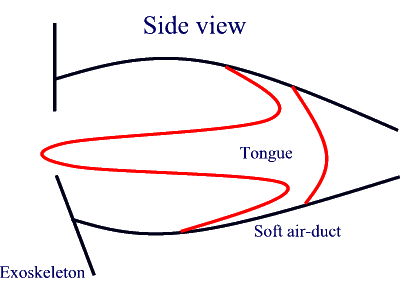 Image from Mikael Johansson |
iii. Positional terms
Important for the continued study of the Daharran phonetics is the ability to describe how and where sounds are made. In the Institution, we use the terms intraportal, postportal, summal and basal to describe the four possible obstruction sites for Daharran consonants. Unal, Binal and Trinal are used for describing how many of the vocal cords are involved in a sound. 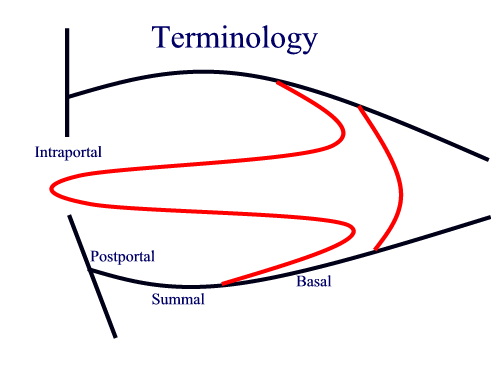 Image from Mikael Johansson |
II. Phonetics
A rather relevant question in the start of Daharran speech studies is what sound they take as being part of language. This splits up in several parts, from the fundamental areas to the more composed areas, ending up in the study of morphology -- of possible syllables.i. Vowel-sounds
The Daharran anatomy does not allow for any rich assortment of vowels -- they distinguish their vowels mainly by pitch, and very little by tone. Thus, we get roughly three vowels that are distinguishable to human ears, and audispectral analyses have not conveyed any contrary information.For the sake of transcription, we denote the high pitched vowel by /e/, the medium pitched by /o/ and the low pitched by /a/.
By most human pidgin-speakers, the vowels are actually pronounced as /e/, /o/ and /a/ respectively. (IPA-Kirschenbaum /e/, /O/ and /6/ respectively), whereas most daharran pidgin-speakers at least understand the human attempts at their vowels.
ii. Consonants
When it comes to pure consonant sounds, they have five places of obstruction. Intraportal, Postportal, Summal and Basal. Furthermore, any consonant may be trilled and every consonant is voiced, but may be partly unvoiced.
Thus we normally classify them after four criteria:
1) is the tongue tip intraportal, postportal, summal or basal?2) is the consonant pronounced as a liquid, as a retroflex liquid, as a
plosive, as a fricative or as an affricative?
3) how many vocal cords are voiced and how many are unvoiced?
4) is the consonant being trilled?
We will get back to consonants, and provide a list of confirmed forms as well as their transcriptions later.
iii. Combination
One very important aspect of Daharran phonetics is that no language sound ever lacks a vowel. There may be sounds consisting only of vowels, but never ever do they pronounce consonants only, and consider it speech. A non-voiced sound is about as linguistic as a cough or a sneeze.
This makes any transcriptions a bit awkward, as we practically have to denote three sounds simultaneously. Current praxis though proscribes denoting each syllable as three letters, of the form CVC (consonant - vowel - consonant), where the consonants are to be ordered in 'alphabetic'
order. (ref: OSI 9455-6454-12a; Metasoft preRFC 99165584F8E93CF)
iv. Consonant lists
Seemingly, in contemporary Daharran, liquids do not exist. The records and the information we have been given indicates that there may have been liquid consonants in archaic Daharran, but we are thoroughly unable to either confirm or deny that.
The consonants given here are those that we have confirmed in Daharran speech, and they are given in the transcription defined in OSI 9455-6454-12a (Metasoft preRFC 99165584F8E93CF).
| Intraportal | Postportal | Summal | Basal | |
| Plosive | pt | t,d | k,q,c | |
| Fricative | s,z,sh,zh | f,v,n,m | h | |
| Affricative | j,tsh,dz,ts | ch,qh,kh |
iv.a. Special consonants
/l/ is most probably a relic from an ancient liquid medium. It is produced as an almost-fricative with only vocal cords involved. The pidgin-pronunciation would be something of a retroflex /l/ -- i.e. curve the tip of the tongue backwards, and 'humm' with toning vocal cords.
iv.b Transcriptional Alphabet as of OSI 9455-6454-12a (Metasoft preRFC 99165584F8E93CF)
(ASCII-IPA for pidgin pronunciation is given in the right column;
see link above)
a 6
d d
dz dz
j dZ
c c A basal plosive performed by the base of the lingua
ch C /c/ but affricative
f f
v v
m m with Daharrans, /m/ and /n/ are the binal versions of /f/ and /v/.
n n this distinction is practically impossible for unmodified humanoids to reproduce.
l l`
e i or 1 or E
k k a basal plosive performed by the tip of the lingua, retroflexed
kh x /k/ but affricative
q ? a basal plosive performed by the vocal cords
qh ?\ /q/ but affricative
o U
h T a bit like /th/ in /think/ -- place the tongue between the teeth and hiss
s s
sh S
z z
zh Z
t t
ts ts
tsh tS
pt a bilabial/dental-alveolar plosive; press together the lips, and release them
with a puff as you put the tongue right behind the teeth to form the second plosive.
v. Syllable scheme
A syllable is in Daharran anything of the form -(C)V(C)- -- where everything between a - - pair is pronounced simultaneously by Daharrans. In
pidgin, the order of the consonants is very free; as long as the correct pair is produced, everything is in order.
For example, the two colonies established in Chronos: Jek-Lon-Kal and Sha-Kat-Jan are to be pronounced in pidgin (using IPA): /dZikl`Unk6l`/ and /S6k6tdZ6n/ respectively.
III. Introductory notes on Syntax
Daharran words are in general very inflected. Their role in a sentence is primarily decided by their inflection, which follows one of several paradigms.
Research into the subject of Daharran inflections is not yet near completion. Therefore, this section of the booklet will inevitably be incomplete, and might be inconsistent with future findings.
i. The Verb
The Daharran Verb is inflected after
- three main paradigms: active, passive and medial
- mood: finite or infinite
- tense
- aspect
- perfection/static
- person, number and case of subjects and objects
i.a Paradigms
The active paradigm takes on the transitive verbs, the passive
intransitive verbs, and medial reflexive verbs.
An active sentence takes a nominative sub-phrase (see ii. on the noun), and also an accusative sub-phrase. In the active sentence, the nominative sub-phrase denotes the agent.
In a passive sentence, the direct object is denoted by the nominative instead of the accusative, and the agent is denoted by the dative case.
A medial sentence normally carries a reflexive meaning. Both the agent and the direct object (or, for some verbs, the indirect object) are denoted by the nominative.
i.b Mood
The mood of the verb denotes in what way the verb is expressed. The verb may be in either one of the finite moods or in one of the infinite moods.
i.b.1 Finite mood
The finite moods express congruence with the subject in their phrase -- i.e. with the word in nominative. There are nine moods in all: indicative, negative, imperative, prohibitive, deliberative, irreal, potential, concessive and oblique.
i.b.1.A Indicative
The indicative mood is used for statements, for facts and for description of the world in general.
i.b.1.B Negative
The negative mood is practically the negation of the indicative. It is used to emphasize on the absence of something.
i.b.1.C Imperative
The imperative mood is used in orders. When the wish of the speaker is for somebody to do something, he uses the imperative mood.
i.b.1.D Prohibitive
The prohibitive mood is used when the speaker wishes to forbid somebody to do something.
i.b.1.E Deliberative
The deliberative mood is used to express uncertainty, confusion, doubt or deliberation about something.
i.b.1.F Irreal
The irreal mood is used to describe something not expected to be possible, not expected to exist etc.
i.b.1.G Potential
The potential mood is used in polite, rhetorical questions and utterances, where the expected answer is the reverse of the statement.
i.b.1.H Concessive
The concessive mood is used when explicitly allowing for something, accepting something; quite possibly not wished, but persuaded into.
i.b.1.I Oblique
The oblique mood is used in indirect speech -- when recounting what has been told by somebody else; when referring to positions that one does not necessarily take oneself.
i.b.2 Infinite moods
Among the infinite moods, we find the infinite verb (verbal substantive) and the participle (verbal adjective).
i.c Tenses
Daharran recognizes three tenses: Present time, past time and future time.
Certain rhetorical constructions have been found that refine these tenses --
normally it is an inflected form of the copulative verb \ptok\ together with an infinite, thus subdividing time into nine different tenses.
i.d Aspect
The aspect of a verb may be singular, progressive, or repeated. The habit of something is normally expressed by a repeated past.
i.e Perfection/Stasis
The verb may also be static-perfect, static-imperfect or dynamic-imperfect. Static implies that no change is taking place, dynamic that there is. Perfect implies that it's all already done; perfected, imperfect that work is still in progress. Thus static-imperfect would imply that nothing is done at the moment, but it is not yet completed.
i.f Person, number and case
See Nouns and Prepositions
ii. Noun
The Daharran nouns may be substantive or adjective. Regardless which, they are inflected after number, case and gender.
They recognize six genders: Masculine, Feminine, Tender, Animate,
Non-animate and Abstract.
They also recognize three numbers: singular (one or two), trial (three) or plural (many).
And they recognize nine (!) cases in three families: Syntactical cases, grammatical cases or locational cases:
ii.a Syntactical cases
The syntactical cases are Nominative, Accusative and Dative.
In an active sentence, the nominative denotes the agent, the accusative the direct object and the dative the indirect object or the one taking benefit from the action.
In a medial sentence, the nominative denotes the agent, and dative and accusative are almost never used.
In a passive sentence, the nominative denotes the direct object, the dative agent and the accusative is rarely present at all.
ii.b Grammatical cases
The grammatical cases are Genitive, Instrumental and Comparative.
Genitive denotes possessor of something, Instrumental the instrument, the means of accomplishing something and the Comparative that to which a comparison is made.
ii.c Locational cases
These have also been called prepositional cases, as they carry precision to prepositional phrases. They are Ablative, Allative and Essive. They denote direction away from (Abl), direction toward (All) or state at or near (Ess); most commonly used in prepositional phrases.
Adjectives are inflected in congruence with the word they describe. Verbal adjectives may also be inflected in congruence with their objects.
IV. Paradigms
i. The verb
We exemplify the verb with one from each of the three conjugations:
Kash-Jel I watch
Me-Ne II reign
Dakh-Qed-O III transcend
i.a Active, Passive and Medial
The active-passive-medial distinction is made solely on the person
ending,
which is attached to the end of the verb after all other
inflections have
been made. We will exemplify with the indicative present singular
static-perfect.
Active
I II III
Singular
1st Kash-Jel-Pte-Qo Me-Ne-De-Qo Dakh-Qed-Pto-Qo
2nd Kash-Jel-Pte-Qa Me-Ne-De-Qa Dakh-Qed-Pto-Qa
3rd Kash-Jel-Pte-Qe Me-Ne-De-Qe Dakh-Qed-Pto-Qe
Trial
1st Kash-Jel-Pte-Sho Me-Ne-De-Sho Dakh-Qed-Pto-Sho
2nd Kash-Jel-Pte-Sha Me-Ne-De-Sha Dakh-Qed-Pto-Sha
3rd Kash-Jel-Pte-She Me-Ne-De-She Dakh-Qed-Pto-She
Plural
1st Kash-Jel-Pte-Zho Me-Ne-De-Zho Dakh-Qed-Pto-Zho
2nd Kash-Jel-Pte-Zha Me-Ne-De-Zha Dakh-Qed-Pto-Zha
3rd Kash-Jel-Pte-Zhe Me-Ne-De-Zhe Dakh-Qed-Pto-Zhe
Passive
I II III
Singular
1st Kash-Jel-Pte-Lo Me-Ne-De-Lo Dakh-Qed-Pto-Lo
2nd Kash-Jel-Pte-La Me-Ne-De-La Dakh-Qed-Pto-La
3rd Kash-Jel-Pte-Le Me-Ne-De-Le Dakh-Qed-Pto-Le
Trial
1st Kash-Jel-Pte-Pto Me-Ne-De-Pto Dakh-Qed-Pto-Pto
2nd Kash-Jel-Pte-Pta Me-Ne-De-Pta Dakh-Qed-Pto-Pta
3rd Kash-Jel-Pte-Pte Me-Ne-De-Pte Dakh-Qed-Pto-Pte
Plural
1st Kash-Jel-Pte-Jo Me-Ne-De-Jo Dakh-Qed-Pto-Jo
2nd Kash-Jel-Pte-Ja Me-Ne-De-Ja Dakh-Qed-Pto-Ja
3rd Kash-Jel-Pte-Je Me-Ne-De-Je Dakh-Qed-Pto-Je
Medial
I II III
Singular
1st Kash-Jel-Pte-Qol Me-Ne-De-Qol Dakh-Qed-Pto-Qol
2nd Kash-Jel-Pte-Qal Me-Ne-De-Qal Dakh-Qed-Pto-Qal
3rd Kash-Jel-Pte-Qel Me-Ne-De-Qel Dakh-Qed-Pto-Qel
Trial
1st Kash-Jel-Pte-Ptosh Me-Ne-De-Ptosh Dakh-Qed-Pto-Ptosh
2nd Kash-Jel-Pte-Ptash Me-Ne-De-Ptash Dakh-Qed-Pto-Ptash
3rd Kash-Jel-Pte-Ptesh Me-Ne-De-Ptesh Dakh-Qed-Pto-Ptesh
Plural
1st Kash-Jel-Pte-Jozh Me-Ne-De-Jozh Dakh-Qed-Pto-Jozh
2nd Kash-Jel-Pte-Jazh Me-Ne-De-Jazh Dakh-Qed-Pto-Jazh
3rd Kash-Jel-Pte-Jezh Me-Ne-De-Jezh Dakh-Qed-Pto-Jezh
i.b Finite mood in all tenses
Mood and tense are expressed in the same syllable -- and affixed
just before
the person/active-passive-medial syllable. In system III, the sole
vowel
forming the last syllable of the stem is augmented by the inflectional
consonants; in the other two systems, there is a vowel harmony between
the
inflected syllable and the last syllable of the stem.
Thus
Present: I II III
Indicative -PtV- -DV- -PtV-
Negative -TsV- -TV- -DzV-
Imperative -QV- -QV- -QV-
Prohibitive -QVqh- -QVqh- -QVqh-
Deliberative -KV- -KV- -KV-
Irreal -KVqh- -KVqh- -KVqh-
Potential -QVkh- -QVkh- -QVkh-
Concessive -LVl- -MV- -FVl-
Oblique -JVpt- -JVpt- -JVdz-
Past: rotate vowels according to a->e->o->a
Future: rotate vowels according to a->o->e->a
Thus Kash-Jel-Pto-Qo would mean that I/we two were watching. (Past
indicative active singular static)
i.c Infinite mood in all paradigms and tenses
The infinite mood lack the person and mood endings discussed in
iii.a.2 and
iii.a.3. Instead, they follow the following system, with last syllable
following the adjective inflection systems:
Active
I (Kash-Jel) II (Me-Ne) III (Dakh-Qed-O)
Present
Infinitive Kash-Jel-Me-Kal Me-Ne-Me-Kal Dakh-Qed-Mo-Kal
Participle Kash-Jel-Me-Jan Me-Ne-Me-Jan Dakh-Qed-Mo-Jan
Past
Infinitive Kash-Jel-Tse-Kal Me-Ne-Tse-Kal Dakh-Qed-Tso-Kal
Participle Kash-Jel-Tse-Jan Me-Ne-Tse-Jan Dakh-Qed-Tso-Jan
Future
Infinitive Kash-Jel-Ve-Kal Me-Ne-Ve-Kal Dakh-Qed-Vo-Kal
Participle Kash-Jel-Ve-Jan Me-Ne-Ve-Jan Dakh-Qed-Vo-Jan
Passive
for present, the infix \-Ne-\,
for past, the infix \-Dze-\ and
for future, the infix \-Fe-\
Medial
for present, the infix \-Le-\
past: \-Tshe-\
future: \-Je-\
i.d Aspect and Stasis
Aspect and Stasis is expressed by a prefix according to the
following schema:
Singular Progressive Repeated
Static-perfect LV- JV-
Static-imperfect SV- LVs- JVs-
Dynamic-imperfect ZV LVZ- JVz-
Note that no prefix is attached to singular static-perfect verbs,
and that
the syllable conforms to the vowel harmony of the first syllable in the
stem.
ii The noun
We exemplify the noun paradigms with different substantives and one
adjective - Sha-Kat-Jan (untranslatable -- probably approx. /like a
flower
burning of unity/).
Masculine
singular trial plural
nominative Jek-Lon-Kal Jek-Lon-Khal Jek-Lon-Khan
accusative Jek-Lon-Qal Jek-Lon-Qhal Jek-Lon-Qhan
dative Jek-Lon-Cal Jek-Lon-Chal Jek-Lon-Chan
genitive Jek-Lon-Tsol Jek-Lon-Tshol Jek-Lon-Tshon
instrumental Jek-Lon-Dzol Jek-Lon-Jol Jek-Lon-Jon
comparative Jek-Lon-Lol Jek-Lon-Lon Jek-Lon-Non
ablative Jek-Lon-Tek Jek-Lon-Tekh Jek-Lon-Tsekh
allative Jek-Lon-Dek Jek-Lon-Dekh Jek-Lon-Dzekh
essive Jek-Lon-Qel Jek-Lon-Qen Jek-Lon-Qhen
'cooperation through alertness'
singular trial plural
nominative Sha-Kat-Dzan Sha-Kat-Jan Sha-Kat-Jal
accusative Sha-Kat-Tsan Sha-Kat-Tshan Sha-Kat-Tshal
dative Sha-Kat-Ptan Sha-Kat-Ptam Sha-Kat-Ptal
genitive Sha-Kat-Tan Sha-Kat-Tam Sha-Kat-Tal
instrumental Sha-Kat-Dan Sha-Kat-Dam Sha-Kat-Dal
comparative Sha-Kat-Han Sha-Kat-Ham Sha-Kat-Hal
ablative Sha-Kat-Qan Sha-Kat-Qam Sha-Kat-Qal
allative Sha-Kat-Qhan Sha-Kat-Qham Sha-Kat-Qhal
essive Sha-Kat-Can Sha-Kat-Cam Sha-Kat-Cal
Feminine
singular trial plural
nominative Qokh-Tal-Kel Qokh-Tal-Khel Qokh-Tal-Khen
accusative Qokh-Tal-Qel Qokh-Tal-Qhel Qokh-Tal-Qhen
dative Qokh-Tal-Cel Qokh-Tal-Chel Qokh-Tal-Chen
genitive Qokh-Tal-Tsel Qokh-Tal-Tshel Qokh-Tal-Tshen
instrumental Qokh-Tal-Dzel Qokh-Tal-Jel Qokh-Tal-Jen
comparative Qokh-Tal-Lel Qokh-Tal-Len Qokh-Tal-Nen
ablative Qokh-Tal-Tek Qokh-Tal-Tekh Qokh-Tal-Tsekh
allative Qokh-Tal-Dek Qokh-Tal-Dekh Qokh-Tal-Dzekh
essive Qokh-Tal-Qel Qokh-Tal-Qhel Qokh-Tal-Qhen
'young female, girl'
singular trial plural
nominative Sha-Kat-Dzen Sha-Kat-Jen Sha-Kat-Jel
accusative Sha-Kat-Tsen Sha-Kat-Tshen Sha-Kat-Tshel
dative Sha-Kat-Pten Sha-Kat-Ptem Sha-Kat-Ptel
genitive Sha-Kat-Ten Sha-Kat-Tem Sha-Kat-Tel
instrumental Sha-Kat-Den Sha-Kat-Dem Sha-Kat-Del
comparative Sha-Kat-Hen Sha-Kat-Hem Sha-Kat-Hel
ablative Sha-Kat-Qen Sha-Kat-Qem Sha-Kat-Qel
allative Sha-Kat-Qhen Sha-Kat-Qhem Sha-Kat-Qhel
essive Sha-Kat-Cen Sha-Kat-Cem Sha-Kat-Cel
Nesttender
singular trial plural
nominative Qokh-Jen-Kol Qokh-Jen-Khol Qokh-Jen-Khon
accusative Qokh-Jen-Qol Qokh-Jen-Qhol Qokh-Jen-Qhon
dative Qokh-Jen-Col Qokh-Jen-Chol Qokh-Jen-Chon
genitive Qokh-Jen-Tsol Qokh-Jen-Tshol Qokh-Jen-Tshon
instrumenJen Qokh-Jen-Dzol Qokh-Jen-Jol Qokh-Jen-Jon
comparative Qokh-Jen-Lol Qokh-Jen-Lon Qokh-Jen-Non
ablative Qokh-Jen-Tok Qokh-Jen-Tokh Qokh-Jen-Tsokh
allative Qokh-Jen-Dok Qokh-Jen-Dokh Qokh-Jen-Dzokh
essive Qokh-Jen-Qol Qokh-Jen-Qhol Qokh-Jen-Qhon
'young nesttender'
singular trial plural
nominative Sha-Kat-Dzon Sha-Kat-Jon Sha-Kat-Jol
accusative Sha-Kat-Tson Sha-Kat-Tshon Sha-Kat-Tshol
dative Sha-Kat-Pton Sha-Kat-Ptom Sha-Kat-Ptol
genitive Sha-Kat-Ton Sha-Kat-Tom Sha-Kat-Tol
instrumental Sha-Kat-Don Sha-Kat-Dom Sha-Kat-Dol
comparative Sha-Kat-Hon Sha-Kat-Hom Sha-Kat-Hol
ablative Sha-Kat-Qon Sha-Kat-Qom Sha-Kat-Qol
allative Sha-Kat-Qhon Sha-Kat-Qhom Sha-Kat-Qhol
essive Sha-Kat-Con Sha-Kat-Com Sha-Kat-Col
Animate
singular trial plural
nominative Sha-Kat-Tad Sha-Kat-Tadz Sha-Kat-Tsadz
accusative Sha-Kat-Dad Sha-Kat-Dadz Sha-Kat-Dzadz
dative Sha-Kat-Tsad Sha-Kat-Tsadz Sha-Kat-Tsaj
genitive Sha-Kat-Kan Sha-Kat-Kam Sha-Kat-Kham
instrumental Sha-Kat-Qan Sha-Kat-Qam Sha-Kat-Qham
comparative Sha-Kat-Can Sha-Kat-Cam Sha-Kat-Cham
ablative Sha-Kat-Das Sha-Kat-Dash Sha-Kat-Dzash
allative Sha-Kat-Tas Sha-Kat-Tash Sha-Kat-Tsash
essive Sha-Kat-Sas Sha-Kat-Sash Sha-Kat-Shash
Non-animate
singular trial plural
nominative Sha-Kat-Tod Sha-Kat-Todz Sha-Kat-Tsodz
accusative Sha-Kat-Dod Sha-Kat-Dodz Sha-Kat-Dzodz
dative Sha-Kat-Tsod Sha-Kat-Tsodz Sha-Kat-Tsoj
genitive Sha-Kat-Kon Sha-Kat-Kom Sha-Kat-Khom
instrumental Sha-Kat-Qon Sha-Kat-Qom Sha-Kat-Qhom
comparative Sha-Kat-Con Sha-Kat-Com Sha-Kat-Chom
ablative Sha-Kat-Dos Sha-Kat-Dosh Sha-Kat-Dzosh
allative Sha-Kat-Tos Sha-Kat-Tosh Sha-Kat-Tsosh
essive Sha-Kat-Sos Sha-Kat-Sosh Sha-Kat-Shosh
Abstract
singular trial plural
nominative Sha-Kat-Ted Sha-Kat-Tedz Sha-Kat-Tsedz
accusative Sha-Kat-Ded Sha-Kat-Dedz Sha-Kat-Dzedz
dative Sha-Kat-Tsed Sha-Kat-Tsedz Sha-Kat-Tsej
genitive Sha-Kat-Ken Sha-Kat-Kem Sha-Kat-Khem
instrumental Sha-Kat-Qen Sha-Kat-Qem Sha-Kat-Qhem
comparative Sha-Kat-Cen Sha-Kat-Cem Sha-Kat-Chem
ablative Sha-Kat-Des Sha-Kat-Desh Sha-Kat-Dzesh
allative Sha-Kat-Tes Sha-Kat-Tesh Sha-Kat-Tsesh
essive Sha-Kat-Ses Sha-Kat-Sesh Sha-Kat-Shesh
Note that animate, inanimate and abstract nouns and adjectives are
inflected
in the same way.
V. Pronouns
i. Personal pronouns
The personal pronouns, in all genders and inflections are:
Masculine
singular trial plural
nominative Kal Khal Khan
accusative Qal Qhal Qhan
dative Cal Chal Chan
genitive Tsol Tshol Tshon
instrumental Dzol Jol Jon
comparative Lol Lon Non
ablative Tek Tekh Tsekh
allative Dek Dekh Dzekh
essive Qel Qen Qhen
Feminine
singular trial plural
nominative Kel Khel Khen
accusative Qel Qhel Qhen
dative Cel Chel Chen
genitive Tsel Tshel Tshen
instrumental Dzel Jel Jen
comparative Lel Len Nen
ablative Tek Tekh Tsekh
allative Dek Dekh Dzekh
essive Qel Qhel Qhen
Nesttender
singular trial plural
nominative Kol Khol Khon
accusative Qol Qhol Qhon
dative Col Chol Chon
genitive Tsol Tshol Tshon
instrumenJen Dzol Jol Jon
comparative Lol Lon Non
ablative Tok Tokh Tsokh
allative Dok Dokh Dzokh
essive Qol Qhol Qhon
Animate
singular trial plural
nominative Tad Tadz Tsadz
accusative Dad Dadz Dzadz
dative Tsad Tsadz Tsaj
genitive Kan Kam Kham
instrumental Qan Qam Qham
comparative Can Cam Cham
ablative Das Dash Dzash
allative Tas Tash Tsash
essive Sas Sash Shash
Non-animate
singular trial plural
nominative Tod Todz Tsodz
accusative Dod Dodz Dzodz
dative Tsod Tsodz Tsoj
genitive Kon Kom Khom
instrumental Qon Qom Qhom
comparative Con Com Chom
ablative Dos Dosh Dzosh
allative Tos Tosh Tsosh
essive Sos Sosh Shosh
Abstract
singular trial plural
nominative Ted Tedz Tsedz
accusative Ded Dedz Dzedz
dative Tsed Tsedz Tsej
genitive Ken Kem Khem
instrumental Qen Qem Qhem
comparative Cen Cem Chem
ablative Des Desh Dzesh
allative Tes Tesh Tsesh
essive Ses Sesh Shesh
In case the person of the pronoun is not apparent from the verb, a
prefix syllable is added according to:
1st person Tsok-
2nd person Dzoc-
3rd person Joq-
ii. Demonstrative pronoun
The demonstrative pronouns are (in their masculine singular):
Qok-Kal this
Tok-Kal that
Hek-Kal this mine, this here
Lel-Kal this your, this there
Led-Kal this his, that there
They are inflected by inserting proper form of the personal pronoun
as the
second syllable.
iii. Reflexive pronoun
Mainly used either to denote reflexivity and yet direct and indirect
objects, thus avoiding the medial, or to enforce the reflexive notion
of the
medial.
Pte-Kal
iv. Miscellaneous
Nen-Kal None, nothing
Ten-Kal Anyone, anything
Tel-Kal Some
Tsen-Kal Every
Len-Kal Any of ... (in genitive)
Tot-Kal relative function
Dod-Kal interrogative function
Non-Kal determinative (relative forward)
Footnotes
(1) For those of you not entirely familiar with the terms:
liquida consonants not obstructing the aerial flow; anglic examples: /r/, /l/
fricative obstructing the aerial flow producing a 'hissing' sound; anglic examples: /s/, /h/
plosive stopping up and then releasing the aerial flow; anglic examples: /k/ /t/
retroflex curving the tongue/lingua backward. Often liquidae. No anglic examples available.
trill vibrating the tongue/lingua. Common in some dialects' pronunciation of /R/.
affricative plosive followed by a fricative
- Chronos Cluster, The
- Daharran - Text by Anders Sandberg
Anglic term for Daharran language - see Booklet on Daharran Grammar for details regarding Daharran speech and vocal apparatus. - Daharran Unity
- Daharrans, The
- Ma-Tesh
Initially published on 10 November 2000.






